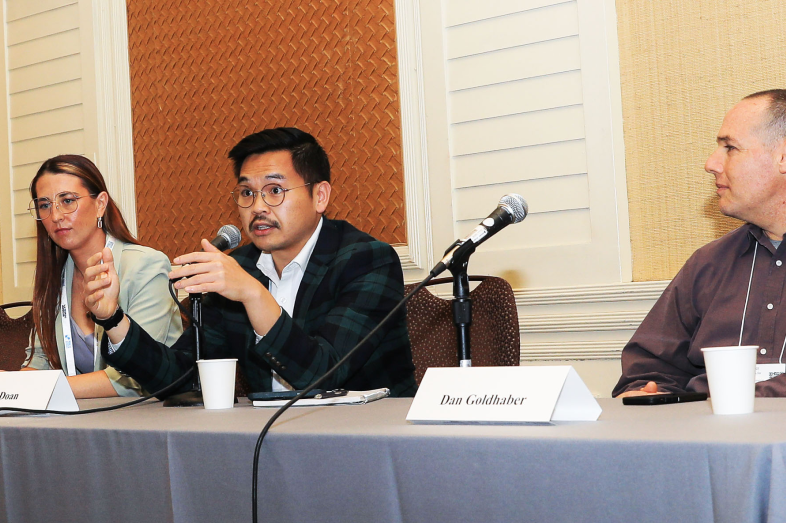
Making Sense of Teacher Workforce Data
Researchers and an educator provide fresh story angles, statistics and sources to better cover the teacher workforce.
Photo credit: James Minichello of AASA for EWA

Researchers and an educator provide fresh story angles, statistics and sources to better cover the teacher workforce.
Photo credit: James Minichello of AASA for EWA
Four years into the challenges caused by the COVID-19 pandemic, the teaching workforce is recovering in some ways, but many schools are still struggling to recruit for key positions.
Madeline Will, an assistant managing editor for Education Week, moderated a panel on the teacher workforce at the Education Writers Association’s 2024 National Seminar in May, featuring three experts:
Download their presentation here. (Scroll through speaker presentations to 1:45 p.m. on May 31). An unedited transcript and audio from the session is also available.
Here are some of the story angles the speakers recommended reporters examine:
While the issue of teacher turnover — which includes teachers leaving the profession or moving to other schools — has gotten more attention since the pandemic, it’s not a new problem for many schools.
Schools that serve more students from lower-income families tend to lose teachers more quickly, Goldhaber said.
He looked at the issue in Washington state over several decades, beginning in the mid-80s. He and his colleague, Roddy Theobald, found that teacher turnover in high-poverty schools was consistently about 4 percentage points higher on average than in low-poverty schools from 2002 to 2022. When examining the pandemic years, Goldhaber’s report shows that the teacher turnover gap increased to a nearly 4.5 percentage point difference after 2022.
When the overall teacher turnover rate hit nearly 20% in Washington in 2022, high-poverty schools had already seen rates that high in many previous years.
“If we think it’s a crisis this year, it’s a crisis for high-poverty schools every year,” Goldhaber said.
The National Teacher and Principal Survey shows different levels of difficulty in filling positions depending on the subject area.
CALDER compiled the data over three decades. Goldhaber found that principals have consistently reported greater difficulty filling positions in STEM (science, technology, engineering and mathematics), special education and English language learning.
When looking at the broadly categorized national data on how schools spent their COVID-relief dollars, it’s difficult to tell how much was spent on staffing.
CALDER looked at it another way, examining the amount of funding each district in Washington state received and the number of new job openings they posted in the same time frame. They found that every $100,000 in COVID-relief funding was associated with about 0.5 more filled staff postings.
With no new pandemic-relief funding coming in the upcoming school year, many school districts are having to cut the staff positions they had funded with federal dollars.
Doan cited a 2023 RAND survey that found about a quarter of school district administrators anticipated a 5% drop in revenues for the 2024-25 school year.
The “pay penalty” for teachers — referring to the salary gap between teachers and other college-educated workers — has grown from about 6.1% in 1996 to a record 26.4% in 2022, according to research by the Economic Policy Institute cited by DeRidder.
Teachers in 2022 made about 74% of what other similarly educated workers made, the Economic Policy Institute shows.
The average national teacher salary is now about $69,544, according to the National Education Association.
“It’s important to know that not every state is the same, and obviously there’s reasons behind that,” DeRidder said. “There’s nuance to all those numbers.”
On RAND’s 2023 State of the American Teacher Survey, about 66% of teachers said their salaries were somewhat or completely inadequate. Those teachers said they desired about a $17,000 raise, which Doan said is about the same size as the gap between the salaries of teachers and similarly educated workers.
Among surveyed teachers who were intending to leave their jobs, most cited low salary as a reason, especially Black and Hispanic teachers who had lower salaries overall.
Black and Hispanic teachers generally have less experience and are more likely to teach in high-poverty school districts that pay lower salaries, the Economic Policy Institute has reported.
Learn more about the experiences of Black teachers and efforts to diversify the teacher workforce by watching this EWA webinar recording.
Your post will be on the website shortly.
We will get back to you shortly